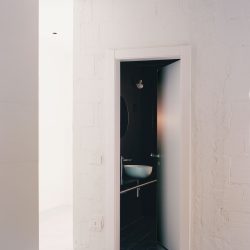
The project incipit always starts with bargaining between the different resources that may present themselves. Economic constraints, regulatory constraints, spatial needs, continuity of materials, new use requirements, energy needs, are all resources that are part of the project, which from time to time retreat or conquer, dominate or succumb, shifting weights and outcomes.
The design concept to become real, from theory to artifact, identifies bargains, sacrifices the superfluous in favor of the fundamental, a quid pro quo. In this sense, the design of a renovation becomes a negotiation of resources that shows the nature of the building, declaring it in exposed structure, missing finishes, saving materials and reusing them.
The project thrives on the contrast between raw materials and detailed elements: on the one hand, industrial concrete, exposed concrete structure bearing the signs of time, unfinished masonry showing the texture of the perforations; on the other hand, designer switches and handles, handcrafted iron elements such as raw iron doors, custom-made downspouts and parapets, alignments between materials and the study of the connecting joints. A white backdrop generates an almost surreal atmosphere where individual elements become protagonists of the space.
On the outside the same color scheme dominates, the plaster and travertine stone pick up the color and materiality of the existing stone, generating a three-dimensionality that combined with the complex pitched roof defines an unified artifact.
Both inside and outside, typological elements little analyzed in architecture such as downspouts and eaves become a design theme, a true experimentation, emerging from a neutral background.
The project is part of a research that Vacuum Atelier carries out called “Super-Domus” with the aim of rewriting a form of contemporary living, identifying a design method and intervention tools. Dwellings as objects that are often repeated in the anonymity of their architectural expression, although containers of compositional elements. The method of intervention is based on the identification of the compositional structure from which follows the formulation of the design action, the sum of a technical, formal or spatial need, through an abacus of adaptive micro interventions.
_


















